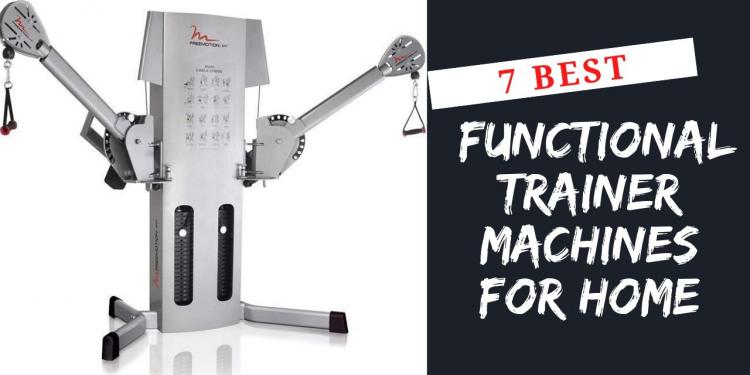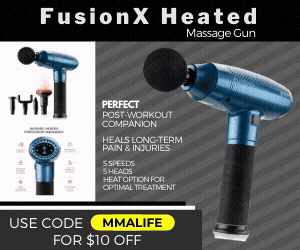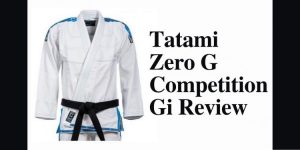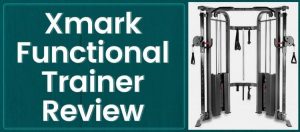It's often overlooked in lieu of big squat racks, pricey "all-in-one" machines hawked in late-night infomercials, and gimmicky gadgets. But functional trainers — long an old standby in traditional gyms — are experiencing a resurgence in popularity among those who want to set up a home gym.
Don't let its basic, simple design fool you. With a functional trainer, you can perform literally countless varieties of your favorite exercises, giving your full body a workout and hitting your fitness goals from the comfort of your home.
We've tried and tested these machines below, and here is our review of the 7 best functional trainers in the market right now.
More...
What is a Functional Trainer?
The concept of a functional trainer is very straightforward: A relatively compact machine made up of two cable columns, one or two weight stacks, and a chin-up/pull-up bar. With these basic features, you perform all your favorite movements, including:
- Balanced work: Feel like one side of your body is stronger than the other? When you use equipment like a barbell, your body often overcompensates with your stronger side/limb. But because a functional trainer lets you adjust the weight stacks independently, you can make sure each side of your body is pulling its weight (pun intended).
- Isolateral and isolation work: Whether you’re in the midst of physical therapy and working on an injury, or you want to hone in and focus on a specific body part, isolateral (single leg/single arm) exercises on a functional trainer get the job done.
- Full-body work: Functional trainers can be used for every major and minor muscle group, from your legs to your abdominal muscles to your upper body and back.
Other benefits of a functional trainer include multi-plane movements so you can hit your muscles from literally every angle and plane of motion, and keeping your muscles under continuous tension (cables, unlike barbells/dumbbells, maintain tension on your muscles during the complete movement and not just when you’re fighting gravity).
However, these benefits are only fully present when you buy the best functional trainers with all the bells and whistles you need. If you’re in the market for a functional trainer, here are a few things to watch for when shopping for your home gym:
1. Does it have two weight stacks?
Cheaper functional trainers sometimes come with just one weight stack, which negates the benefits of balanced work that we noted above. With two weight stacks, you can ensure every muscle/limb is doing the work it should be.
2. Is it compact enough?
Every functional trainer requires varying levels of floor space. Make sure it fits in the space you have, and don’t forget that you’ll need adequate space above and around the functional trainer to stand, lean, squat, jump and move.
3. What adjustments does it offer?
For the best results, you want a functional trainer that offers numerous height and length adjustments for bars, pulleys, etc. A machine that doesn’t modify to your personal needs won’t just reduce your exercise enjoyment, but may also increase your workout injury risks.
You’ll also want to check what extra attachments and products your machine comes with, whether that’s wrist straps, curl bars, ropes, etc. If there’s a specific thing you enjoy using, it may be an extra cost.
4. What are its weight limits?
Depending on the machine you’re buying, you may have a 150-pound or 200-pound weight stack. Keep in mind that due to the nature of pulleys, functional trainers give you a functional advantage over static weights so you can likely lift/pull heavier on this machine than you could with a dumbbell or barbell.
5. Does it have a good chin-up/pull-up bar?
This is a core component of your new functional trainer, and it should be exactly what you need. The best functional trainers have a bar that offers numerous grip options and styles, which helps you shift the focus on different muscle groups, and also saves your joints from fatigue and tendonitis.
The best functional trainers offer all the above, and more. But what works perfectly for one athlete may be completely different for another athlete based on your needs, height, preferences and fitness goals.
Every functional trainer on the market offers specific pros and cons. Below, we’ve compiled the seven best functional trainers for home gyms.
Each in-depth functional trainer review will guide you through which one to choose that best fits your purposes, and features or drawbacks to keep an eye on.
A Note About Pulley/Cable Resistance Ratios
In the review below, we use the term "weight resistance ratio" or "weight ratio." What is this ratio? This technical term refers to the way a pulley system in a functional trainer works. Thanks to all those cables, angles and pulleys in the machine, you aren't lifting/pulling the exact weight you might have chosen in the weight stack when you initially pull. The first number is the resistance of the pulley/cable and the second number is the actual weight you are pulling. The lower the ratio (e.g. 1:1), the more "accurate" the weight (ideal if you're focused on building strength and lifting heavy) from start to finish. The higher the ratio (e.g. 2:1), the smoother and quicker the lifting/pulling action (ideal if you're focused on enhancing speed, plyometrics, explosive movements, etc.) but the "lighter" the actual weight you're initially pulling. Essentially, with a ratio, you are getting more help from the pulley system to get the weight initially off the stack. Once the weight is off the stack, you are still working with the true weight.
The common misconception with the resistance ratio is that you are not working with the true weight. That's not true. You are working with the stated weight. It is just that you are getting a little help to get the weight off the stack. Think of it like a bench press spotter, initially helping you get the barbell off the bench. If there is 300 pounds on the barbell, you are still benching 300 pounds. It is just that you are getting a little help at the start with the spotter.
You will see the ratio stated differently on some other websites. Neither is wrong. It is just what numbers are used first second. On this chart, the first number is the cable weight you are working with, and the second number is the "true" weight. So 2:1 means 210 pounds of resistance will initially feel like 105 pounds of the stack.
Functional Trainer Comparison Chart
Product and Price Range | Resistance Ratio | Shipping Weight | Assembly Time | Weights Included? | Rating |
|---|---|---|---|---|---|
 XMark Functional Trainer Cable Machine $$$ *Editor's Choice* | 1:1 | 827 lbs (375 kg) | > 10 hrs | Yes (200 lbs per side) | 9.5/10 Best for versatility and space-saving |
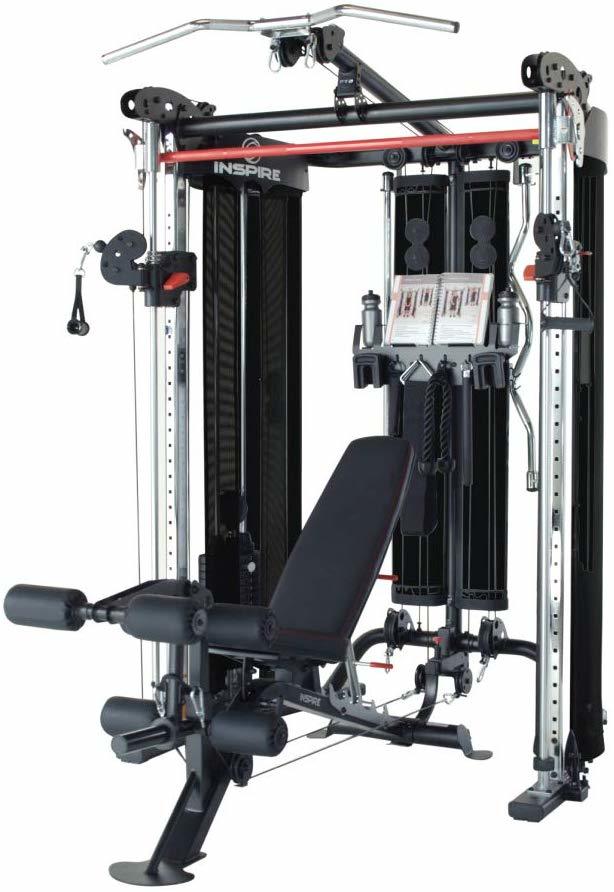 Inspire Fitness FT2 Functional Trainer $$$$$ | 2:1 | 731 lbs (332 kg) | 1 to 5 hrs | Yes (165 lbs per side) | 9/10 Best for lower body and Olympic lifts |
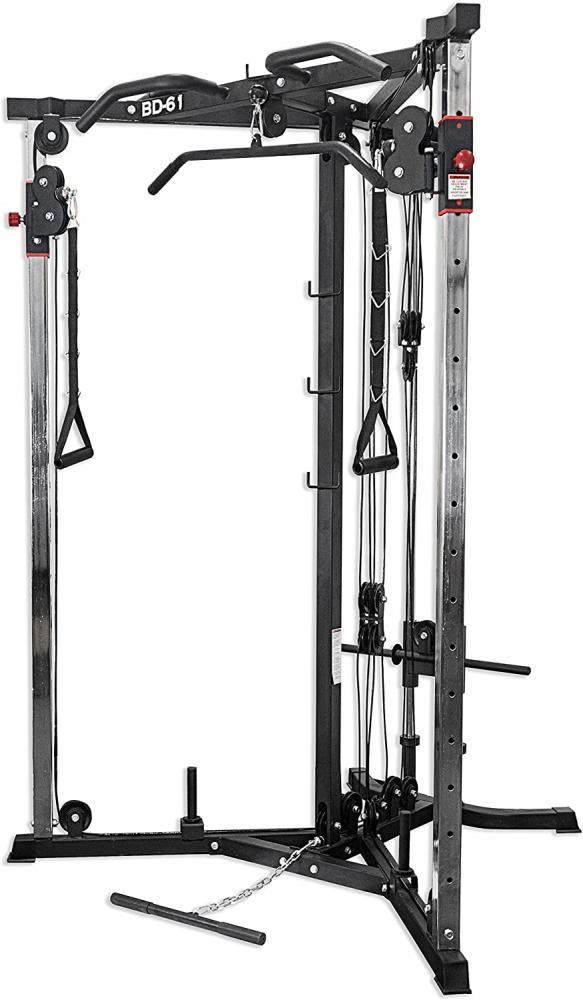 Valor Fitness BD-61 $ | 1:1 | 165 lbs (75 kg) | 6 to 10 hrs | No | 9/10 Best for budget-conscious and no frills |
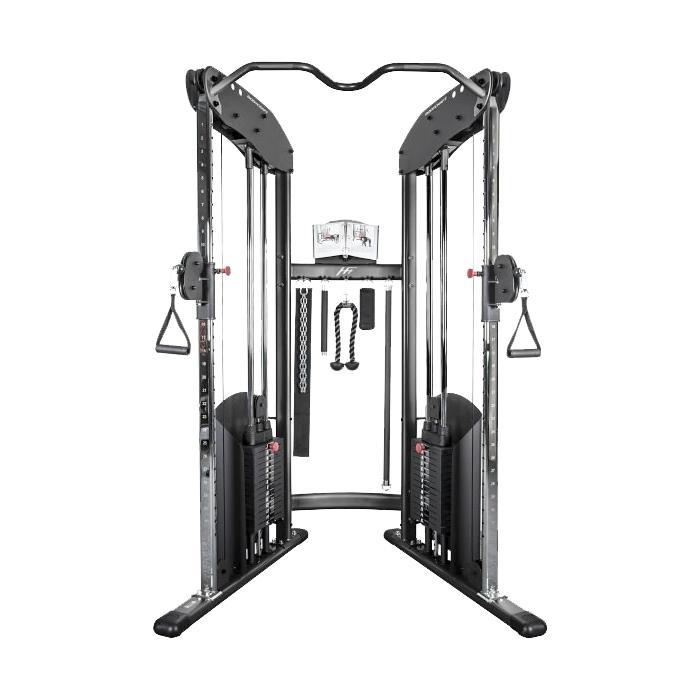 BodyCraft HFT Functional Trainer $$$ | 2:1 | 530 lbs (240 kg) | 1 to 5 hrs | Yes (150 or 200 lbs per side) | 9/10 Best for machine durability and safety |
 Body-Solid Powerline PFT100 Functional Trainer $$ | 2:1 | 509 lbs (231 kg) | 1 to 5 hrs | Yes (160 lbs per side) | 9/10 Budget-conscious with features of higher end trainers |
 FreeMotion Dual Cable EXT $$$$$ | 3:1 | 997 lbs (452 kg) | 1 to 5 hrs | Yes (210 lbs per side) | 8.5/10 Best for athletes focusing on stability and coordination |
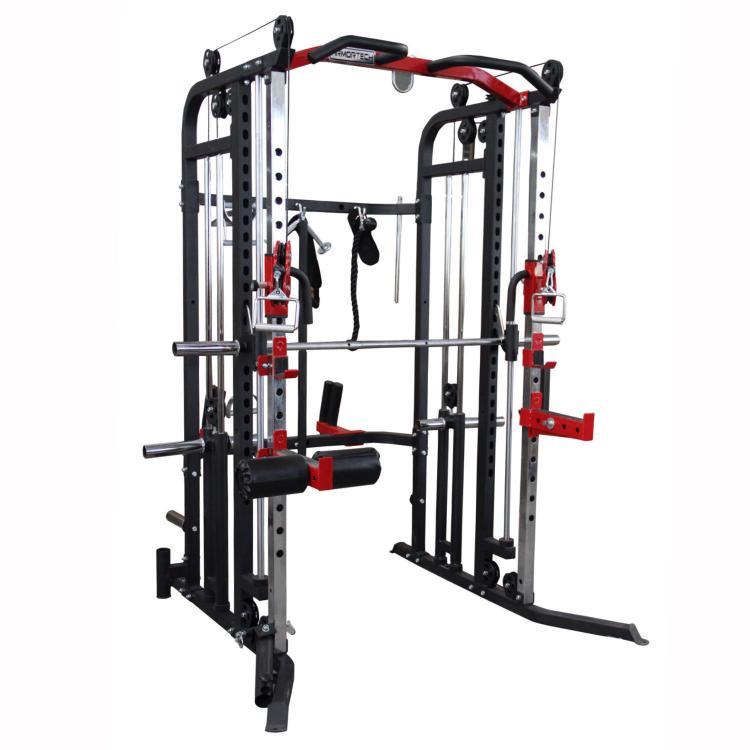 F30 Pro Functional Trainer $$$$$ | N/A | 500 lbs (227 kg) | > 10 hrs | No | 8.5/10 Best for fitness enthusiast |
1. XMark Functional Trainer Cable Machine

XMark Functional Trainer Cable Machine
XMark's offering to the functional trainer market is all about compact, space-saving design and quick, easy adjustments.
The first thing you'll notice is the way its solid, 2-inch by 3-inch steel mainframe is angled perfectly for sliding into a corner in your home gym (a side benefit of this wedge shape is that it also creates extra stability when performing pull-ups/chin-ups). Since XMark needed only 48 inches between weight stacks and 60 inches between the pulleys, the equipment only requires 52 inches of clearance on the left and right.
And when it comes to versatility, the quick-adjust pulleys on the XMark trainer can accommodate a wide range of angles and motions. There are an impressive 19 adjustment slots with the highest slot at 6'6" and the lowest setting at 1', so you can adjust exercises like high tricep pulls or low cable-flys exactly to your liking, no matter your height.
The dual weight stacks, each offering up to 200 pounds total, are set at a 1:1 ratio. Some functional trainers have a much higher ratio, so when you pull or lift a certain weight, the pulley mechanics mean you’re actually lifting less than the true weight. Not so with the XMark functional trainer, so what you’re moving on the XMark is similar to what you might perform in another gym.
Technical details:
- Weight limit of resistance: 200-lb dual weight stacks
- Shipping Weight: 827 pounds
- Assembled Dimensions (Length x Width x Height): 43.5 x 65 x 83 inches
- Attachments:
- Includes: Hand straps, tricep rope, short bar, long bar, leg extension, leg curl/leg curl strap, ankle strap
- Optional add-ons: A half rack for squats, a 3-way adjustable bench, a dumbbell 2-tier rack, etc.
Pros:
- Wedge shape makes this functional trainer ideal for a corner placement while boosting the machine’s stability.
- High quality look and feel, such as the durable powder coat finish, give this functional trainer a similar feel to a commercial gym’s offerings.
- The weight stacks max out at 200 pounds each, which is higher than many other functional trainers.
- An incredible 19 height settings allow for a wide range of adjustments, no matter your age, height or specific exercise.
Cons:
- Assembly is complicated and takes some buyers a day or two to complete.
- The assembly instructions rely mostly on diagrams, and a lack of text and very few zoomed-in diagrams/illustrations pose quite challenging for many buyers.
- The pulley carriages (which you slide up and down when adjusting) can sometimes get stuck or feel “rough” when moving. However, the XMark includes a bottle of lubricant.
Rating: 9.5/10
Best for: Someone needed a wide range of versatility/adjustability in a space-saving design
2. Inspire Fitness FT2 Functional Trainer

Inspire Fitness FT2 Functional Trainer
The Inspire FT2 functional trainer immediately stands out in the crowd for its unique integration of an Olympic bar. The manufacturer designed the Olympic bar to use the trainer’s built-in weight stacks, thus completely eliminating the need for Olympic weight plates and making re-racking your bar faster and safer.
Unlike many other functional trainers, Inspire's option also offers a built-in Smith machine, for those of you who love to build the lower body muscle groups with lunges, squats, etc.
The dual pulley system offers 32 adjustable positions, and the pull-up bar can be adjusted if your home gym’s ceiling is low.
One interesting point to highlight are the dual weight stacks, because the math confuses many potential buyers. The default option when buying the Inspire FT2 functional trainer is only 165-pounds on each side. The way this breaks down is 10 pounds for the weight stack itself, 150-pounds of weight plates built into the machine, and a 5-pound bumper weight (two are included by default so you have one for each side).
If you need more weight in your workout, the manufacturer sells two 50-pound weight stacks (one for each side), which would raise the weight of each pulley to a maximum of 215-pounds. The resistance ratio for this trainer is 2:1.
Technical details:
- Weight limit of resistance: 165-lb dual weight stacks
- Shipping Weight: 731 pounds
- Assembled Dimensions (Length x Width x Height): 57.9 x 61 x 87.8 inches
- Attachments:
- Includes: Tricep rope, hand straps, straight bar, EZ curl bar, ankle straps, water bottles, multi-function belt, two 5-lb. add-on weights
- Optional add-ons: Preacher curl attachment kit, leg extension conversion kit, adjustable bench
Pros:
- All-steel design with electrostatic powder coat and precision steel belt systems ensure durability.
- Unique design offers plate-free Olympic bar workouts.
- “Weight multiplier” lets you increase cable resistance if you find the weight stacks aren’t heavy enough. This is a feature unique to this specific manufacturer.
- Simple construction and clear documentation means assembly only takes 3-4 hours for many buyers.
Cons:
- The default option has a maximum weight of just 165-pounds on each side, which is likely too low for some fitness enthusiasts.
- If you’re tall, (6’ or taller) you may find some of the pulley height settings too low for comfort. The pull-up bar is also only 7-feet off the ground, so you may need to bend your legs when using it.
- Some buyers complain about the quality of the add-on, such as the padding on the leg extension bar, the seams on the bench and the durability of the Velcro straps.
- This functional trainer is hardly the tallest or widest, nor is it the smallest, instead offering a middle-ground, average approach to being neither compact nor too large.
Rating: 9/10
Best for: Athletes who want to cover all the basics, but especially want to focus on the lower body and Olympic lifts
3. Valor Fitness BD-61

Valor Fitness BD-61
It's obvious at your very first glance: The BD-61 cable crossover machine from Valor Fitness is no-nonsense and no-frills. This makes it one of the most budget-friendly and one of the most compact functional trainers ever, so long as you aren’t looking for big add-ons or fancy gadgets.
The premise is straightforward: A simple wedge-shaped, steel frame offers two dual cable pulley systems that provide 17 adjustable positions.
And instead of built-in weight stacks, you'll use either Standard plates or Olympic plates (four Olympic adapter sleeves are included) up to a total maximum of 400 pounds. Because it requires plates, storage pegs are built-in to keep your home gym organized and tidy.
While features are minimal, the included and optional add-ons, such as a curl bar, let you hit all major muscle groups for a complete, full-body workout. Small details, such as rubber base caps to help protect your floor, show the manufacturer didn’t sacrifice quality when keeping things simple and no-frills.
Technical details:
- Weight limit of resistance: 400-pound maximum
- Shipping Weight: 165 pounds
- Assembled Dimensions (Length x Width x Height): 56 x 52 x 80 inches
- Attachments:
- Includes: Lat bar, row bar, two adjustable single-strap handles
- Optional add-ons: rotating v-handle bar, triangle chest pull, tricep rope, stirrup handle bar
Pros:
- When it comes to price, you’ll be hard pressed to find a more budget-friendly option. This is ideal for athletes who just want the basics.
- Assembly takes four to six hours.
- A fairly low weight resistance ratio of 1:1 helps you know you're lifting your "true" weight.
- Dual pulley system lets you hit both sides of your body equally, or single pulls.
- Bottom storage units for your weight plates means this functional trainer doesn’t need to be bolted to the floor when weighted.
Cons:
- Heavy drag on the pulleys makes adjustments less seamless than other functional trainers.
- You get what you pay for. Some buyers find this model feels “cheap,” and others report that various elements, such as the pull-up bar, feel flimsy compared to other functional trainers.
- The compact shape can actually be a drawback for some. For instance, it’s too cramped to do bicep curls while standing inside the machine itself. Plan for needing some extra space around your BD-61 for such activities.
- The no-frills design and lack of add-ons means some movements, such as leg exercises or side lateral raises, can be fairly limited.
- Make sure you buy from a reputable source. Some buyers have reported missing parts or “glitches” like no holes for bolts when buying from third parties.
Rating: 8/10
Best for: The no-frills athlete who wants a big workout on a small budget
4. BodyCraft HFT Functional Trainer

BodyCraft HFT Functional Trainer
Oval steel tube construction, and sleek chrome uprights, give this functional trainer a much different, brighter aesthetic compared to many of the dark, powder-coated options on the market. But it’s not just the visuals that are different.
The BodyCraft HFT offers various outstanding safety and durability features that you may find appealing, especially compared to other functional trainers.
For instance, it includes a protective steel cover for the rear stacks, sealed ball bearings for smoother gliding, fiberglass-reinforced nylon pulleys, and aircraft-rated steel ropes with a whopping 2,000-pound tensile strength. The result is a functional trainer that doesn’t just look different, but stands up to the abuse of daily workouts.
Beyond the advanced safety and durability features, you'll also get all the popular settings common in many functional trainers. For instance, you’ll find 180-degree rotating pulleys that adjust to 31 different height positions, so you can hit your muscles from any elevation and any angle.
Alas, a few drawbacks, such as the default model coming with just 150 pounds of weight, detract from an otherwise solid functional trainer.
The resistance ratio for this trainer is 2:1.
Technical details:
- Weight limit of resistance: 150-lb dual weight stacks
- Shipping Weight: 530 pounds
- Assembled Dimensions (Length x Width x Height): 38 x 55 x 82 inches
- Attachments:
- Includes: Two single handles, long bar, sport stick, triceps rope, chin-up/push-up assistant strap, ankle cuff, two chains and an integrated multi-grip chin bar
- Optional add-ons: Extra 50-pound add-ons for a 200-lb dual weight stack
Pros:
- Advanced durability and safety features ensure longevity for both you and the machine.
- Independent pulleys rotate a full 180 degrees for a wide range of motion during workouts.
- Assembly is a relatively quick two to four hours thanks to a well-documented, detailed instruction manual.
- Relatively compact, wedge shape works well in small rooms and tight corners.
- An unusually comprehensive warranty provides lifetime protection for the fram and the parts if used in a home setting.
Cons:
- By default, this comes with just 150-pounds in each weight stack. Upgrading to a 200-lb weight stack is an added cost.
- The chrome and polished steel look is eye-catching, but may attract lots of fingerprints.
- The compact shape may be too narrow for some people to work out inside the functional trainer.
- A bench is not included, even though it’s necessary for many popular workouts.
Rating: 9/10
Best for: The athlete focused on safety and machine durability
5. Body-Solid Powerline PFT100 Functional Trainer

Body-Solid Powerline PFT100 Functional Trainer
The PFT100 from Body-Solid offers far more features than sub-$1,000 functional trainers (we're looking at you, Valor Fitness BD-61), while still not breaking the bank.
What you get is the quality and appearance of higher-end models, with features stripped down to only what's absolutely essential for a workout. This also means you do not get a big box of included add-ons and attachments (e.g. ankle straps, EZ curl bars, etc.). Buyers can instead choose exactly what they want to add on, spending money only on what they find personally useful.
You get all the standards you'd expect from a functional trainer, including pulleys that swivel a full 180 degrees, and 20 different height adjustments for said pulleys. Interestingly, the dual weight stacks come with a default 160 pounds each. Should you opt to buy a weight upgrade, you’ll get a total of 210 pounds on each stack, which is pushing above the average you see in most other functional trainers.
Also unlike many other functional trainers, the PFT100’s weight ratio is only 2 : 1, for a good balance between smooth movement and a close-to-true weight-lifting experience.
Finally, nearly everything in the PFT100 is upgradable, which may be both a pro and a con. On the plus side, you can keep the base price as low as possible. On the negative side, you may be sacrificing quality, and the upgrades can quickly add up. For instance, do you need a bench? That's extra. Want aluminum pulleys instead of nylon pulleys? That's also an extra.
Technical details:
- Weight limit of resistance: 160-lb dual weight stacks
- Shipping Weight: 509 pounds
- Assembled Dimensions (Length x Width x Height): 42.3 x 62.6 x 83 inches
- Attachments:
- Includes: Two adjustable nylon handles
- Optional add-ons: Ankle strap, tricep rope, ab crunch harness, weight stack adapter plate, etc.
Pros:
- A budget-friendly option for those who want more than a bare bones cable machine, but who also don’t want to shell out thousands and thousands on a functional trainer.
- Comparatively low weight ratio of just 2:1.
- Adjustable, 180-degree pulleys, with customers raving about its quiet, smooth operation.
- Relatively wider and more spacious than many models.
- Very quick assembly, with many customers saying it took them two hours or less to complete.
Cons:
- All upgrades and extras have an added cost that can quickly add up.
- Boxy shape isn’t as conducive to placement in a corner.
- Depending on where you purchase this from, it may arrive in 10+ different boxes, which makes sorting parts and assembly tricky for some.
Rating: 9/10
Best for: The budget athlete who wants as many features as possible
6. FreeMotion Dual Cable EXT

FreeMotion Dual Cable EXT
The dual-cable cross design breaks away from the functional trainer pack for a few notable reasons. First, you have pulleys attached two independently rotating arms versus a traditional functional trainer's static frame. Each arm can rotate to nine different horizontal settings, and 12 vertical settings.
This offers a far more dynamic range of motion, better mimicking the range of motion you may experience in daily life and better improving your muscles' coordination and stability.
It's your choice if you want to use the two arms for a dual-arm exercise, or create a single-arm workout (the machine is wide enough that two people can use each arm separately, if you're doing a partner workout!).
When it comes to weight, the EXT model comes with dual weight stacks of 210 pounds. However, the newer Genesis model (which builds off of the EXT version) starts at an incredible 240 pounds. Either model trends heavier than most other functional trainers.
Alas, the numbers are a bit misleading. Due to its design, this functional trainer's weight ratio is also 3:1, which means if you're lifting 210 pounds, it's the equivalent of lifting a 75-pound dumbbell with each arm.
Finally, due to its swiveling arm design, you aren’t going to get features common in other functional trainers, such as a pull-up bar, a bench, or the ability to add-on extensions like a Smith machine. With the FreeMotion machine, you’re looking at primarily cable pulls for your legs, arms and torso.
Technical details:
- Weight limit of resistance: 210-lb dual weight stacks
- Shipping Weight: 997 pounds
- Assembled Dimensions (Length x Width x Height): 38 x 63 x 74 inches
- Attachments:
- Includes: Two handles, ankle cuffs
- Optional add-ons: Not applicable
Pros:
- Independently rotating arms offer functional fitness benefits with a very dynamic range of motion for any workout.
- Very heavy, solid steel construction (with full power coating) makes for an extra stable, durable feel.
- A smaller footprint and lower height clearance, largely in part because this trainer doesn’t have a big box-y frame, makes it great for the space conscious.
- Weight plates are in 3-pound increments, making it perfect for those going slow or who are rehabilitating an injury.
- Simple assembly process only takes a few hours to finish.
Cons:
- Lacks a pull-up bar and other features common in other functional trainers, which may impact the type of workouts you enjoy doing. This is potentially the biggest drawback for this trainer’s unique design.
- Weighing nearly 1,000 pounds, you won’t be moving this machine anytime soon once you set it up.
Rating: 8.5/10
Best for: Athletes who want functional fitness with a focus on stability and coordination
7. F30 Pro Functional Trainer (currently unavailable in USA)

F30 Pro Functional Trainer
The "pro" denotation should give you a hint. This model, designed by Armortech, goes above and beyond, featuring not just a functional trainer but also a power rack and a Smith machine. Whereas many functional trainers are great additions to a home gym, the F30 Pro Multi Functional Trainer could arguably be your entire home gym all-in-one.
Unlike most functional trainers (including the next model in the line, the F40), this home gym setup includes two weight stacks. However, a big difference is that the weights themselves are NOT built-in as a weight stack with pins.
Instead, the F30 functional trainer uses your choice of either Standard plates or Olympic plates, allowing for greater customization of exactly how much you're pulling, pushing or lifting when using the pulleys. And since the weights aren't built-in, Armortech conveniently provides built-in storage for your plates.
On the plus side, this means you have greater control over the weights. On the negative side, you’ll have to stock up on what you need, and likely head back to the store when you progress beyond the weights you have. That being said, this is one of the few functional trainers on the market that give you this amount of customization.
Other features that many buyers love is its heavy-duty steel construction. Everything from its cables and pulleys, to its barbell hooks, are built with longevity in mind. Even the easily adjustable safety hooks in its frame are made of solid steel.
Because this functional trainer includes more than most, such as the power rack and Smith machine, it is compact but takes a bit more space than other functional trainers that don't have such a complete system. What you might sacrifice for space, you more than make up with all the extra add-ons.
Technical details:
- Weight limit of resistance: N/A (the two weight stacks use plates that you choose)
- Shipping Weight: 500.45 pounds (227 kg)
- Assembled Dimensions (Length x Width x Height): 71.6 x 57.9 x 87.4 inches
- Attachments:
- Includes: Dip handles, Lat Bar, Straight Bar – 2x Handle Straps – Tricep Rope, V-Bar, Seated Row Bar, Ab Strap, Ankle Strap, Core Trainer
- Optional Attachment Kit: Includes a D Lat bar, Short straight bar, 2 x D handles, Ab Strap, V Bar, Seated Row, Tricep rope, Ankle Strap
Pros:
- Far more than “just” a functional trainer, with features (e.g. a Smith machine, a power rack) not seen in most other functional trainers.
- A true all-in-one station that allows of traditional squats, etc.
- Uses Olympic or Standard plates instead of built-in weights for added versatility.
- Includes weight plate storage as well as barbell storage.
Cons:
- All the extra equipment means this functional trainer is bigger and heavier than most.
- No built-in weight stacks means adjustments while working out take a little longer.
- You’ll need to buy weight plates (not included).
- There are no anecdotal estimates on assembly time, but it’s safe to say construction will be more complicated than other functional trainers simply due to the more complex design and added features. Give yourself at least 10 hours to assemble.
Rating: 8.5/10
Best for: The fitness enthusiast who wants it all

